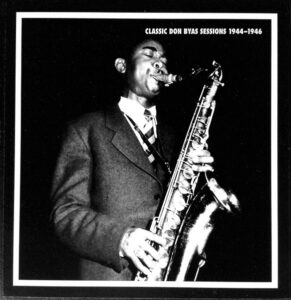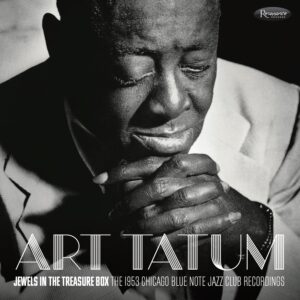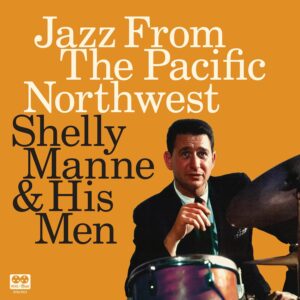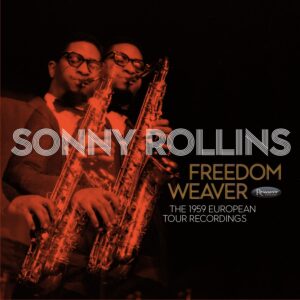“CLASSIC DON BYAS SESSIONS” (Mosaic 277)
With a deep knowledge of harmony (learned from his mentor Art Tatum) and a playing style easily adapted to fit nearly any setting, Don Byas was a first-call tenor saxophonist at a time when jazz was renewing itself every week. Mosaic’s 11-CD set, “Classic Don Byas Sessions”  covers only two years of Byas’ career—from 1944 to 1946—and despite the presence of nearly 200 tracks, it does not cover Byas’ complete recordings of that period. Indeed, the Mosaic booklet lists Byas’ remaining sessions from these two years. These recordings were all omitted due to licensing issues, but had they been included, there would have been enough additional music to fill three more discs!
covers only two years of Byas’ career—from 1944 to 1946—and despite the presence of nearly 200 tracks, it does not cover Byas’ complete recordings of that period. Indeed, the Mosaic booklet lists Byas’ remaining sessions from these two years. These recordings were all omitted due to licensing issues, but had they been included, there would have been enough additional music to fill three more discs!
Swing was giving way to bebop in those years, and Byas was hired for most of the era’s major recording sessions. Several of the key early bop dates are here, including Oscar Pettiford‘s “Something for You” date, the Clyde Hart/Rubberlegs Williams tracks with Dizzy Gillespie and Charlie Parker, Gillespie’s 1945 Manor date (but without “I Can’t Get Started” because Byas only played in the background) and Byas’ 1946 Savoy session featuring “Candy”, “Byas-a-Drink” and “How High the Moon”. As the boppers appreciated Byas’ mastery of chromatic harmony, the swingsters loved his rich tone and romantic approach to ballads (On several occasions, Byas referred to his instrument as the sexophone. This set has many ballad tracks to prove the amorous point.) On the swing sessions, Byas can be heard with Frankie Newton, Hot Lips Page, Emmett Berry, Trummy Young, J.C. Higginbotham, Erroll Garner, Johnny Guarnieri, Sid Catlett, Cozy Cole, and the seemingly ubiquitous Slam Stewart.
One of the most interesting aspects of this collection is that despite Byas’ presence on nearly every track, he is not always the center of attention. For example, deep within the Timme Rosenkrantz section, there is a stunning 1944 session led by Thelonious Monk—three years before his first “official” recordings as a leader! At 27 years old, the pianist had little experience compared to some of the other musicians at the session, yet he is clearly in charge of the music. He never loses his own identity, even when making spontaneous harmonic adjustments to assist a less-talented musician. Loren Schoenberg‘s detailed notes are invaluable here, as he isolates elements from this session that were later integrated into Monk’s compositions.
The set is split into three distinct sections: Byas’ complete recordings for the Savoy label are neatly presented on the first 3 discs. His appearances at informal jam sessions in the apartment of Timme Rosenkrantz appear on the next 3 and a half CDs, and all available sides from small independent labels round out the set. This layout is perfect for those who wish to approach this music one section at a time. However, I decided to listen to the tracks in chronological order so I could hear the swing-to-bop transition as the tracks progressed. That effort required a large coffee table to lay out all of the discs and booklets, plus two separate disc players, one with programmable tracks, so I could seamlessly move between discs. No matter how this music is approached, this Mosaic set is an invaluable record of the changing music scene in mid-40s New York, and a tribute to Don Byas, who played an important role in that evolution.
NAT KING COLE: “AT THE BLUE NOTE, CHICAGO” (Iconic 5)/
ART TATUM: “JEWELS IN THE TREASURE BOX” (Resonance 2064)
From the late 1940s through the early 1960s, Chicago’s Blue Note jazz club was a major destination for musicians and fans alike. The club’s owner, Frank Holzfeind, started as a lover of New Orleans jazz, but through his friendship with radio host Dave Garroway, he soon  embraced big bands, bebop, and cool jazz. The Blue Note was the first of downtown Chicago’s clubs to be fully integrated, with black and white customers seated together at tables all across the floor. The club also had a special section for underage listeners which was located close to the stage, but away from the imbibing customers. Holzfeind had long-standing friendships with many musicians, and he often cut special deals to invite them to play at this club (Apparently, Holzfeind made such a sweetheart deal with Dave Brubeck that the club did not turn a profit until the pianist’s fourth appearance!)
embraced big bands, bebop, and cool jazz. The Blue Note was the first of downtown Chicago’s clubs to be fully integrated, with black and white customers seated together at tables all across the floor. The club also had a special section for underage listeners which was located close to the stage, but away from the imbibing customers. Holzfeind had long-standing friendships with many musicians, and he often cut special deals to invite them to play at this club (Apparently, Holzfeind made such a sweetheart deal with Dave Brubeck that the club did not turn a profit until the pianist’s fourth appearance!)
The Blue Note had a radio wire with NBC, and many recordings of live broadcasts have been issued over the years. But Holzfeind had a little secret: he made his own recordings from the club using 2 overhead stage microphones wired to a Webcor open reel recorder located in the back office. The approach to these recordings was quite cavalier: the recordings were only made when someone remembered to load a reel of blank tape and start the machine. No one monitored the recordings to adjust for distortion, or presumably to flip the reels when the tape ran out. Further, the microphones did not always remain in the same place, so the instrumental balance was inconsistent. Not too many people knew about Holzfeind’s stash of tapes but a few recordings appeared in recent years on the now-dormant Uptown label. With the concurrent issue of Nat King Cole‘s “At the Blue Note, Chicago” and Art Tatum‘s “Jewels in the Treasure Box“, we have over four hours of performances unheard since August 1953. Interestingly, these recordings actually overlap as both Tatum and Cole played sets on August 28. This was the date for a major Blue Note show honoring the city’s disc jockeys. We know that the final section of the Tatum set was recorded on this date, and it is possible that the second disc of the Cole set is also from the same event.
In August 1953, Nat Cole had a huge following, and a lot of hit records. He had stopped public appearances with his trio almost two years earlier, but still brought the group into the studio for occasional recordings. This made his Blue Note trio engagement both fun and challenging. To satisfy the general fans, he performed short (2-3 minute) versions of his most famous songs, but to reconnect to his jazz roots, Cole included piano improvisations on many of the tunes. Unlike his earlier jazz recordings, Cole creates fresh music on the spot, instead of repeating rote solos. Aware of his star power, he is perfectly willing to let the crowd sing along on “Walkin’ My Baby Back Home” but he quickly silences an intoxicated listener when she tries to make a second song request. Cole, guitarist John Collins, bassist Charlie Harris, and drummer Lee Young, sound like they having a great time. That feeling transmits through the recording as it offers a rare look of Nat Cole in a relaxed setting.
Art Tatum also appeared with his trio, featuring guitarist Everett Barksdale and bassist Slam Stewart (there he is again). Of course, Tatum could give listeners an earful when performing alone, but in adding the two extra musicians, the music became denser and difficult to follow. Tatum would usually take the first solo, but when Barksdale entered for his choruses, Tatum was not satisfied to simply play chords as a background. Instead, Tatum would continue soloing alongside Barksdale. Stewart’s solos provided the only respite to the ocean of sound as Tatum and Barksdale backed off for a moment. In and of themselves, the trio performances are stunning, but the constant reiteration of the same solo pattern makes it very challenging to listen for extended periods. I first played this album while on a long train trip, and I soon realized that I would appreciate the music more if I took a break after each disc. Even then, I found myself going back to listen for a second or third time. Compared to Cole, Tatum sounds like he is annoyed by the audience noise. He specifically asks for quiet when he turns from trio to solo performances, and while we don’t hear more than a handful of solo pieces, they are the true jewels of this collection.
follow. Tatum would usually take the first solo, but when Barksdale entered for his choruses, Tatum was not satisfied to simply play chords as a background. Instead, Tatum would continue soloing alongside Barksdale. Stewart’s solos provided the only respite to the ocean of sound as Tatum and Barksdale backed off for a moment. In and of themselves, the trio performances are stunning, but the constant reiteration of the same solo pattern makes it very challenging to listen for extended periods. I first played this album while on a long train trip, and I soon realized that I would appreciate the music more if I took a break after each disc. Even then, I found myself going back to listen for a second or third time. Compared to Cole, Tatum sounds like he is annoyed by the audience noise. He specifically asks for quiet when he turns from trio to solo performances, and while we don’t hear more than a handful of solo pieces, they are the true jewels of this collection.
Hopefully, jazz researchers will examine the contents of the Blue Note archive. It is quite likely that other fine performances are waiting for their first commercial release. We don’t know if any musicians were aware they were being recorded at the time, but the new CDs have the approval of the Cole and Tatum estates.
SHELLY MANNE & HIS MEN: “JAZZ FROM THE PACIFIC NORTHWEST” (Reel to Real 12)
In the 1950s and 1960s, Shelly Manne led one of the most consistent jazz combos on the West Coast. Even when the personnel shifted due  to schedules, Shelly Manne and His Men always represented the best in straight-ahead jazz. Manne, one of the most creative percussionists in jazz history, surrounded himself with outstanding musicians who could follow Manne’s lead through a series of specific (and usually non-verbal) cues. Manne’s wide-ranging group of colleagues included several prominent jazz composers, and Manne would commission new works to challenge his musicians. When playing standards, the group played inventive arrangements that brought new insights to the music. A new double CD from Reel to Real, “Jazz from the Pacific Northwest” offers sample performances of Manne’s group in 1958 and 1966. While only Manne and his bassist Monty Budwig appear on both dates, the band retains a very high performing standard.
to schedules, Shelly Manne and His Men always represented the best in straight-ahead jazz. Manne, one of the most creative percussionists in jazz history, surrounded himself with outstanding musicians who could follow Manne’s lead through a series of specific (and usually non-verbal) cues. Manne’s wide-ranging group of colleagues included several prominent jazz composers, and Manne would commission new works to challenge his musicians. When playing standards, the group played inventive arrangements that brought new insights to the music. A new double CD from Reel to Real, “Jazz from the Pacific Northwest” offers sample performances of Manne’s group in 1958 and 1966. While only Manne and his bassist Monty Budwig appear on both dates, the band retains a very high performing standard.
The album title is something of a misnomer, as the earlier performance was recorded at the inaugural Monterey Jazz Festival in central California; the later set stems from Seattle, part of the true Pacific Northwest. The early set features one lesser-known standard preceding two originals, Charlie Mariano‘s “Vamp’s Blues” and Bill Holman‘s “Quartet (Suite in 4 Movements)”. This was Manne’s first of four recordings of the Mariano piece, and it would become a staple in the group’s repertoire as a vehicle for the blues. Trumpeter Stu Williamson and alto saxophonist Herb Geller play Mariano’s complex theme with ease, and each successfully maneuvers the structural obstacles in the opening portions of their solos. Russ Freeman (piano), Budwig, and Manne are an exceptional rhythm section, keeping the beat swinging and buoyant. The Holman piece was first recorded two years prior with Mariano on alto and Leroy Vinnegar on bass. Holman effectively varies the sounds between composition and improvisation, but on the whole, the composition is not very memorable; however, Manne’s improvised solo on mallets is exceptionally sculpted and perfectly realized.
The second set (actually two radio broadcasts presented back-to-back) is more straight-ahead. Conte Candoli and Frank Strozier comprise the front line, with guest vocalist Ruth Price added for the last track of each broadcast. Hampton Hawes is the pianist and as a temporary sub for Freeman, he seems a little out of his element. His comping is in a different time frame than the rest of the band, and the absence of piano chords as the harmonies progress reveals that the horn players are working with minimal support. Price’s contributions come off better as she takes considerable liberties with the melody lines of “Dearly Beloved” and “The Surrey with the Fringe on Top”.
At just under 86 minutes, this double CD is a little skimpy, plus the leap from 1958 to 1966 is rather severe. It’s too late to fix this set, but if another Manne set is in the works, why not include the 1960 Manchester concert by the group featuring Joe Gordon, Richie Kamuca, Freeman, Budwig, and Manne? This is the same band (with Victor Feldman subbing for Freeman) that recorded Manne’s classic recordings from the Black Hawk in San Francisco. The Manchester concert has superb music and has only been issued on bootleg discs. It would be a worthy addition to another collection of Manne live sets.
SONNY ROLLINS: “FREEDOM WEAVER” (Resonance 2065)
The European concert recordings contained in Resonance‘s new Sonny Rollins collection, “Freedom Weaver” document an important time  in the saxophonist’s career. Placed in an uneasy competition with his friend John Coltrane as one of the two best tenor men in modern jazz, the increasingly self-critical Rollins was about to walk away from the scene for a sabbatical marked by extended practice sessions atop the Williamsburg bridge. Rollins had concert tours to fulfill first, and during his first trip to the Continent, Rollins crisscrossed Western Europe for nearly three weeks. Traveling along with the saxophonist were bassist Henry Grimes and—initially—Pete La Roca Sims. The drummer had recorded with Rollins at the Village Vanguard in November 1957, and joined Rollins’ touring trio just over a year later. Grimes had been with Rollins since October 1958, and endured a tense bus tour with a primarily Caucasian lineup.
in the saxophonist’s career. Placed in an uneasy competition with his friend John Coltrane as one of the two best tenor men in modern jazz, the increasingly self-critical Rollins was about to walk away from the scene for a sabbatical marked by extended practice sessions atop the Williamsburg bridge. Rollins had concert tours to fulfill first, and during his first trip to the Continent, Rollins crisscrossed Western Europe for nearly three weeks. Traveling along with the saxophonist were bassist Henry Grimes and—initially—Pete La Roca Sims. The drummer had recorded with Rollins at the Village Vanguard in November 1957, and joined Rollins’ touring trio just over a year later. Grimes had been with Rollins since October 1958, and endured a tense bus tour with a primarily Caucasian lineup.
On tour, it is typical for an artist to repeat the same repertoire from one city to the next. The Resonance set includes four different versions of the obscure standard “I’ve Told Every Little Star”, and the differences are significant. Rollins first recorded this song on the album “Sonny Rollins and the Contemporary Leaders“, and his interpretation included a recurring figure of two upward rips occurring on the third beat of the seventh bar followed by a rest on beat 4, and three more quarter-note rips on the first three beats of bar eight. On the live version from Laren, Holland on February 21 (the first night of the tour) Rollins sounds pleased with the figure, even though he never refers to it in his improvisation. He seems a little restless about the main melody, as he stylizes it with sardonic scoops before closing with an off-kilter version of the rip figure. By March 4 on a radio broadcast from Stockholm, he plays the rip figure off-mike, perhaps to avoid over-modulating the microphone, but in retrospect, Rollins might have been trying to distance himself from the figure. His solo has less rhythmic freedom than on the previous version, but the groove, now established by all three men is much stronger. Grimes gets a solo this time, and he walks through with exceptional time and tone. Rollins and LaRoca Sims trade fours before Rollins toys with the melody, again playing the riff figure off mic but this time, developing the idea by moving it up and down to different pitch levels before reprising it at the end. At a concert in Zurich the next night, Rollins plays the song fairly straight, digging into the swinging rhythm during his solo. He quotes the tune at a few spots, usually as reference points rather than the beginning of a thematic development. Grimes’ bass solo is shifted to a spot following a short set of fours between the sax and drums. As Grimes finishes his chorus, Rollins and LaRoca Sims sneak in, Rollins plays another full solo and then returns to the theme. The rip figure is again off mic but this time its final appearance in the cadenza appears only after Rollins segues into it at the end of another phrase. The last version comes from a concert in Frankfurt on March 9. The tempo is noticeably slower and it sounds like Rollins has lost interest in this ditty. He plods through the tune and the fire of the rip figure is extinguished. Ironically, his solo here may be the most interesting of the lot, with great use of fragmented lines played against the beat.
After a tense concert in Paris the following evening, LaRoca Sims was out of a job. Rollins replaced him with the veteran drummer Kenny Clarke, and on the three extended tracks recorded in Aix-en-Provence on March 11, Rollins blows with abandon and freedom. Rollins would tour the US during that summer, but after a performance at the Playboy Jazz Festival in Chicago, he decided to stop touring and recording for an undetermined amount of time. He would not return until 1962.
Blue Note has recently reissued “A Night at the Village Vanguard“. The recordings were newly remastered from the 7 ½ ips tapes recorded at the club. The sound is improved from the earlier CD issues, but the only additions are a few spoken announcements. The set booklet includes a new liner essay, and several photos from the original date.